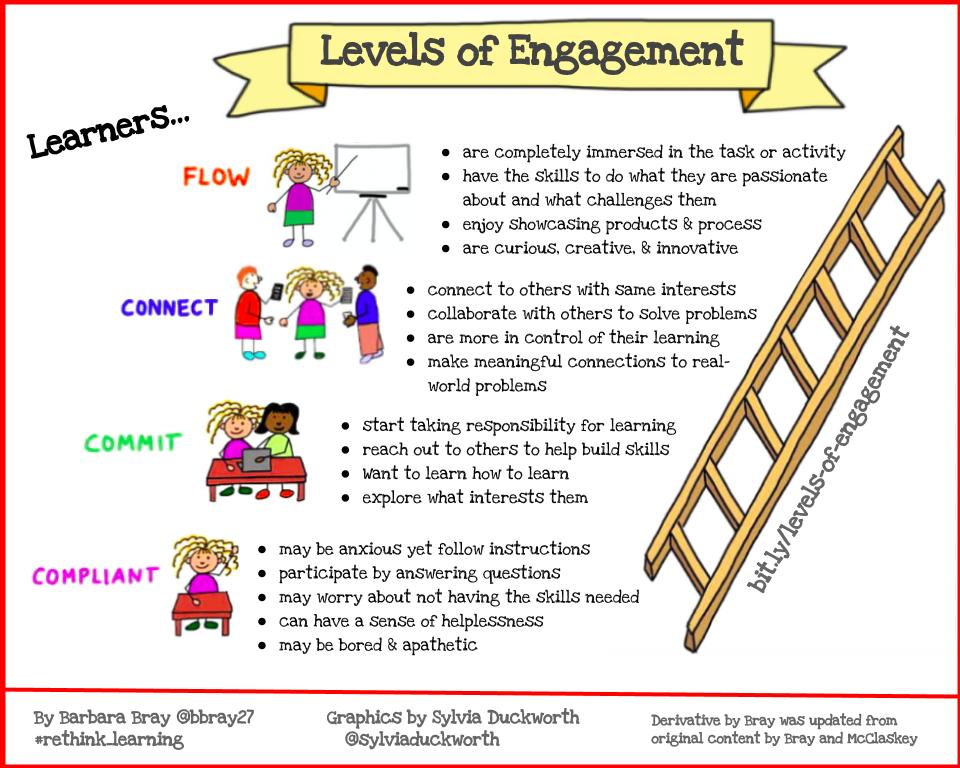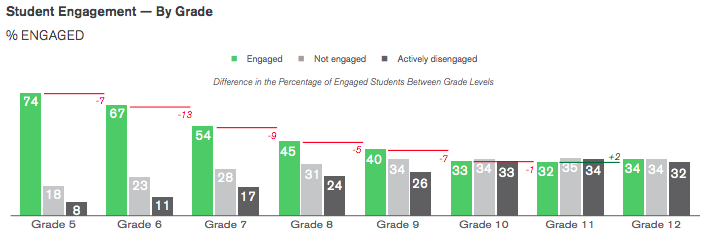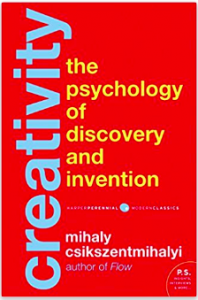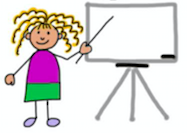
The Levels of Engagement design was created by Barbara Bray using some of the original content by Bray and Kathleen McClaskey with graphics by Sylvia Duckworth. Updated content and design is licensed under a Creative Commons Attribution-NonCommercial-NoDerivatives 4.0 International License
The original Continuum of Engagement focused on the teacher’s role in engaging students. After reading more about engagement with the “Flow” theory and the differences between engagement and empowerment, I believed it needed to be clearer that engagement is about how much any learner is engaged in a task or activity and the balance between the challenge before them and the skills they have to meet that challenge. Empowerment is what the learner or someone else can do to encourage engagement. The levels are more about how the learner is engaged in learning, not about the teacher or the learning environment. Yet, teachers are learners, too and they can create experiences and environments that are compassionate, creative and innovative. This idea of levels of engagement can pertain to any of us who are defining who we are as a learner.
Defining Engagement
Engagement is the affective side of learning and has been found to be a robust predictor of learner performance and behavior in the classroom. (Martin-Kniep, 2012) Engagement refers to the degree of attention, curiosity, interest, optimism, and passion that learners show when they are learning. So this may mean “engagement” is about how much we learn in the classroom or anywhere we learn. I needed to explore this more so checked out the 2016 Gallup Poll.
Measuring hope and engagement, the Gallup Student Poll helps educators gauge school success beyond test scores and grades. With nearly 5 million since 2009, the 2016 survey helps educators provide a more positive school culture — one that builds engagement, creates hope for the future, fosters talent and prepares students to meaningfully participate in the economy. Gallup Student Poll measures are linked to desirable learning outcomes, including self-reported grades, the perception of school success and self-reported absenteeism.

Download the 2016 snapshot report to learn more about how to empower hope and engagement in school. From the results, it is apparent in the Gallup Study that engagement decreased over the years in school. Yet, learning can happen anywhere and at any time especially now with content available at our fingertips. Some questions for you to consider when discussing engagement:
- Do we only measure learning that happens in a school?
- Are teachers or a school responsible for engaging the learners?
- Can teachers empower learners to want to be more engaged in learning?
- Have you noticed some learners more engaged than others?
- Could it be who the learners are that impacts their level of engagement?
- How does the environment impact the learning?
- What might keep some learners from being engaged in the learning process?
- How much does the system have to do with stopping curiosity, creativity, and engagement?
- What can we do to transform the system so learners are more curious, creative, and engaged in learning?
Flow Theory
When learners have a voice and choice in what and how they are learning especially if it is about something they are passionate about or interested in, they jump in and can get lost in the task or project. This is called “flow.” When learners are in the flow, you can notice, see and hear the engagement. Sometimes flow is quiet.

The Psychology of Optimal Experience. New York: Harper and Row]
 Mihaly Csikszentmihalyi is best known as the architect of the theory of flow. Flow is when a person is fully immersed in what they are doing and there is a balance between the challenge of the task and the skill of the learner. Flow cannot occur if the task is too easy or too difficult. Csíkszentmihályi published the graph above that depicts the relationship between the challenges of a task and skills. Flow only occurs when the activity is a higher-than-average challenge and requires above-average skills. Both skill level and challenge level must be matched and high; if skill and challenge are low and matched, then apathy results. (Csíkszentmihályi, 1990)
Mihaly Csikszentmihalyi is best known as the architect of the theory of flow. Flow is when a person is fully immersed in what they are doing and there is a balance between the challenge of the task and the skill of the learner. Flow cannot occur if the task is too easy or too difficult. Csíkszentmihályi published the graph above that depicts the relationship between the challenges of a task and skills. Flow only occurs when the activity is a higher-than-average challenge and requires above-average skills. Both skill level and challenge level must be matched and high; if skill and challenge are low and matched, then apathy results. (Csíkszentmihályi, 1990)
In Creativity: Flow and the Psychology of Invention and Discover (2013), Csíkszentmihályi explains why creativity is so fascinating that when we are involved in it, we feel that we are living more fully than during the rest of our lives. The examples and stories in the book help the reader understand how we change when we are immersed in an activity we are passionate about.
Levels of Engagement
Compliant
 In the Compliant level, learners may appear to be bored or anxious. Some may just give up on learning and follow whatever the teacher or school requires them to do. They may be good “students” who know how to “do” school. Their grades may be good but they are not empowered to do more than they have to do for a grade. There are others that have a fixed mindset and just give up because they were not empowered to learn or do not have a voice in what and how they learn. The school system might be focusing on test scores, worksheets, and homework that are probably not relevant or meaningful for the disengaged learner. The teacher may feel they are the only one responsible and accountable for all the learning in their classroom. Sometimes learners who are compliant have other issues at home that keep them from being engaged in learning.
In the Compliant level, learners may appear to be bored or anxious. Some may just give up on learning and follow whatever the teacher or school requires them to do. They may be good “students” who know how to “do” school. Their grades may be good but they are not empowered to do more than they have to do for a grade. There are others that have a fixed mindset and just give up because they were not empowered to learn or do not have a voice in what and how they learn. The school system might be focusing on test scores, worksheets, and homework that are probably not relevant or meaningful for the disengaged learner. The teacher may feel they are the only one responsible and accountable for all the learning in their classroom. Sometimes learners who are compliant have other issues at home that keep them from being engaged in learning.
Commit
 At the Commit level, learners are starting to take on more responsibility for their learning. The teacher is building relationships with the learners by guiding the process for them to understand how they learn best. At this level, the teacher may still be laying the groundwork for learning and determining prior knowledge but learners may be demonstrating that they are more involved in what and how they learn. The commit level is where the learners find their voice to help become better learners. When they understand why they may be anxious about learning something, they discuss this with the teacher to help them through their anxiety. Learners are also reaching out to others to help them build the skills they will need to perform a task. They commit even more to want to learn when they have time to explore what interests them. This level is where learning is personal and the student finds out more about themselves and who they are as a learner. This is also the level where the teacher realizes that some children need more time or may have other issues keeping them from learning. The teacher-student relationship is so crucial at this level for all learners to help find their voice.
At the Commit level, learners are starting to take on more responsibility for their learning. The teacher is building relationships with the learners by guiding the process for them to understand how they learn best. At this level, the teacher may still be laying the groundwork for learning and determining prior knowledge but learners may be demonstrating that they are more involved in what and how they learn. The commit level is where the learners find their voice to help become better learners. When they understand why they may be anxious about learning something, they discuss this with the teacher to help them through their anxiety. Learners are also reaching out to others to help them build the skills they will need to perform a task. They commit even more to want to learn when they have time to explore what interests them. This level is where learning is personal and the student finds out more about themselves and who they are as a learner. This is also the level where the teacher realizes that some children need more time or may have other issues keeping them from learning. The teacher-student relationship is so crucial at this level for all learners to help find their voice.
Connect
 In the Connect level, learners realize now that learning is social. They can expand on what they learned at the commit level by connecting with others who are at the same level or have the same interests. They are more in control of their learning but realize they can learn much more if they collaborate with others who can work together to build on their ideas. At this level, the learners are doing more of the talking than the teacher. This is where learners enjoy learning from each other and even teaching their peers. Learners are more engaged at this level when connected to real-world problems that are relevant to them. Today, learners connect with smart devices before and after school. Teachers and schools can make this level more effective if these smart devices are allowed during school hours. This is where “trust” and “letting go” of control can be so important. Our learners are using these devices and need to know the appropriate use so they can connect globally in an effective and safe way. This is the level where you notice it is getting a little noisier in some parts of the classroom.
In the Connect level, learners realize now that learning is social. They can expand on what they learned at the commit level by connecting with others who are at the same level or have the same interests. They are more in control of their learning but realize they can learn much more if they collaborate with others who can work together to build on their ideas. At this level, the learners are doing more of the talking than the teacher. This is where learners enjoy learning from each other and even teaching their peers. Learners are more engaged at this level when connected to real-world problems that are relevant to them. Today, learners connect with smart devices before and after school. Teachers and schools can make this level more effective if these smart devices are allowed during school hours. This is where “trust” and “letting go” of control can be so important. Our learners are using these devices and need to know the appropriate use so they can connect globally in an effective and safe way. This is the level where you notice it is getting a little noisier in some parts of the classroom.
Flow
 At the Flow level, many call it “messy learning” because it may seem chaotic to some people. Learners are curious, creative, and innovative. There is no one way to capture what it might look like. A few learners might be in the hall, another on a smartphone contacting a mentor, two sitting together animated on the floor in the back of the room, a small group brainstorming in the corner, and someone presenting evidence of learning to others for critical feedback. Some learners are working quietly immersed in the task at hand where others are reaching out to others to collaborate on solving a problem. This is when learners have the skills to pursue their interests and are curious by seeking what they are passionate about. They want to challenge themselves to investigate and solve solutions to real-world problems where they can make a difference. You can hear it in their voices and actions. They want to share what they learn. The teacher is more of a mentor and coach as they guide the process. This level is when learners self-advocate for what they need or want to learn and when they have agency.
At the Flow level, many call it “messy learning” because it may seem chaotic to some people. Learners are curious, creative, and innovative. There is no one way to capture what it might look like. A few learners might be in the hall, another on a smartphone contacting a mentor, two sitting together animated on the floor in the back of the room, a small group brainstorming in the corner, and someone presenting evidence of learning to others for critical feedback. Some learners are working quietly immersed in the task at hand where others are reaching out to others to collaborate on solving a problem. This is when learners have the skills to pursue their interests and are curious by seeking what they are passionate about. They want to challenge themselves to investigate and solve solutions to real-world problems where they can make a difference. You can hear it in their voices and actions. They want to share what they learn. The teacher is more of a mentor and coach as they guide the process. This level is when learners self-advocate for what they need or want to learn and when they have agency.
****
What I did notice about the engagement is that sometimes we are in the flow because of the activity or task at hand. Other times we may not be engaged because of the activity. We may be at different levels at home or at school or in other learning environments. The engagement level can be high in a makerspace and low in a classroom depending on the activities.
Several teachers have said to me that when their kids are in the flow, “they never want to go back to the traditional way of teaching.” Some questions for you to think about and reflect on:
Have you experienced flow?
How much flow did you experience in school?
Where are you in the Levels of Engagement?
What about your learners in your classroom?
Do you notice different levels of engagement with different activities?
*****
Resources
Csikszentmihalyi, M. (1990) Flow: The Psychology of Optimal Experience. New York. Harper & Row.
Martin-Kniep, G. (2012) 27. Neuroscience of engagement and SCARF: why they matter to school.
https://lciltd.org/WebsitePublications/HandbookNeuroleadership_EngagementArticleGMK.pdf
*****
Thank You to Sylvia Duckworth @sylviaduckworth from Toronto, Canada for designing the graphics for the Levels of Engagement. Please make sure you visit http://sylviaduckworth.com for all the graphics she created and to ask her for permission to use any of her graphics.
*****
A few relevant websites about moving to learner agency:
- Opportunities for Choice
- Spectrum of Voice
- Development of Ownership
- Build a Toolkit so Learners are Future Ready
- Defining Learner Agency
- Teaching and Learning Continuum



[…] Levels of Engagement: Balancing Challenges and SkillsJuly 14, 2018 […]
[…] Levels of Engagement […]
[…] Levels of Engagement […]
[…] Levels of Engagement […]
[…] Read the post here… […]
[…] to my post Levels of Engagement: Balancing Challenges and Skills that brings in research on flow and moving from […]